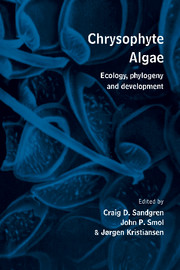Book contents
- Frontmatter
- Contents
- Preface
- List of contributors
- 1 History of chrysophyte research: origin and development of concepts and ideas
- Part I Phylogeny, systematics and evolution
- Part II Development, physiology and nutrition
- 5 Comparative aspects of chrysophyte nutrition with emphasis on carbon, phosphorus and nitrogen
- 6 Mixotrophy in chrysophytes
- 7 Biomineralization and scale production in the Chrysophyta
- 8 Immunological and ultrastructural studies of scale development and deployment in Mallomonas and Apedinella
- Part III Ecology, paleoecology and reproduction
- Part IV Contributed original papers
- Index of scientific names
- Subject index
7 - Biomineralization and scale production in the Chrysophyta
Published online by Cambridge University Press: 05 March 2012
- Frontmatter
- Contents
- Preface
- List of contributors
- 1 History of chrysophyte research: origin and development of concepts and ideas
- Part I Phylogeny, systematics and evolution
- Part II Development, physiology and nutrition
- 5 Comparative aspects of chrysophyte nutrition with emphasis on carbon, phosphorus and nitrogen
- 6 Mixotrophy in chrysophytes
- 7 Biomineralization and scale production in the Chrysophyta
- 8 Immunological and ultrastructural studies of scale development and deployment in Mallomonas and Apedinella
- Part III Ecology, paleoecology and reproduction
- Part IV Contributed original papers
- Index of scientific names
- Subject index
Summary
Introduction
Biomineralization is the process by which living organisms assemble structures from naturally occurring inorganic compounds. Most groups of living organisms have members that deposit minerals and in many instances the mineralized structures provide skeletal support and protection for softer organic parts. Within the Chrysophyta a diverse range of biomineralized structures are produced (Preisig 1986). The biogenic material most extensively deposited by chrysophytes is silica, which occurs almost universally in stomatocysts and is commonly present in mineralized scales. Other minerals are deposited by members of the Chrysophyceae as well. For instance, iron and manganese mineralized material occurs in the brown-colored stalks of Anthophysa vegetans, the brown-colored loricae of Pseudokephyrion pseudospirale, and the gelatinous holdfasts of Phaeothamnion articulata (Preisig 1986). Calcareous deposits are rare in the Chrysophyta, being limited to the pseudocysts of a few species of the Sarcinochrysidales and the mucilage of some species, such as Celloniella, which form gelatinous colonies (Preisig 1986; see Moestrup, this volume).
This review is concerned with the utilization of silica by chrysophytes. The information will be presented in the overall context of the biogeochemical cycling of silica.
Biogeochemical cycling of silica
Silicon is the second most abundant element in the Earth's crust, accounting for some 28% of its mass. Invariably it occurs in chemical composition with oxygen, as in the crystalline and cryptocrystalline polymers of silica (SiO2). Common naturally-occurring substances in- volving additional elements include: kaolinite, feldspars, micas, and the so-called clay minerals (Stumm & Morgan 1970).
- Type
- Chapter
- Information
- Chrysophyte AlgaeEcology, Phylogeny and Development, pp. 141 - 164Publisher: Cambridge University PressPrint publication year: 1995
- 13
- Cited by

